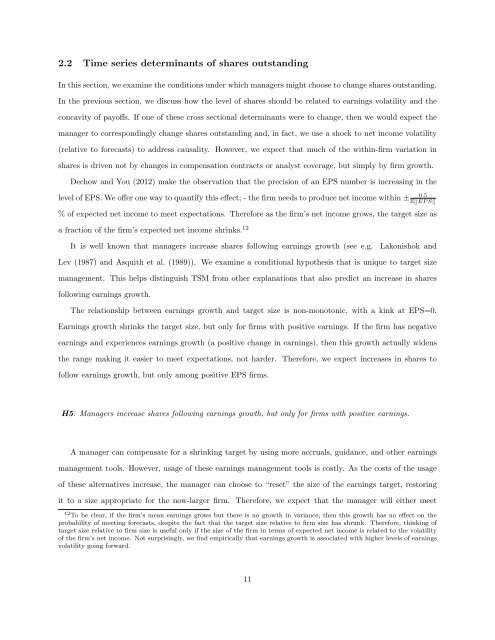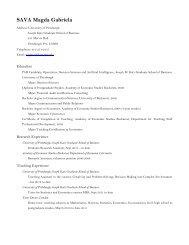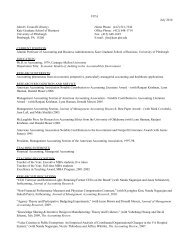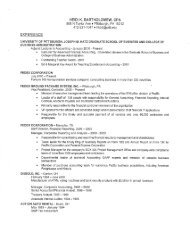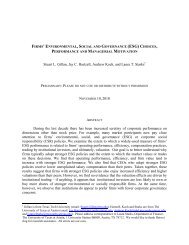Gaming the Float: How Managers Respond to EPS-based Incentives
Gaming the Float: How Managers Respond to EPS-based Incentives
Gaming the Float: How Managers Respond to EPS-based Incentives
Create successful ePaper yourself
Turn your PDF publications into a flip-book with our unique Google optimized e-Paper software.
2.2 Time series determinants of shares outstanding<br />
In this section, we examine <strong>the</strong> conditions under which managers might choose <strong>to</strong> change shares outstanding.<br />
In <strong>the</strong> previous section, we discuss how <strong>the</strong> level of shares should be related <strong>to</strong> earnings volatility and <strong>the</strong><br />
concavity of payoffs. If one of <strong>the</strong>se cross sectional determinants were <strong>to</strong> change, <strong>the</strong>n we would expect <strong>the</strong><br />
manager <strong>to</strong> correspondingly change shares outstanding and, in fact, we use a shock <strong>to</strong> net income volatility<br />
(relative <strong>to</strong> forecasts) <strong>to</strong> address causality. <strong>How</strong>ever, we expect that much of <strong>the</strong> within-firm variation in<br />
shares is driven not by changes in compensation contracts or analyst coverage, but simply by firm growth.<br />
Dechow and You (2012) make <strong>the</strong> observation that <strong>the</strong> precision of an <strong>EPS</strong> number is increasing in <strong>the</strong><br />
level of <strong>EPS</strong>. We offer one way <strong>to</strong> quantify this effect; - <strong>the</strong> firm needs <strong>to</strong> produce net income within ± 0.5<br />
E[|EP S|]<br />
% of expected net income <strong>to</strong> meet expectations. Therefore as <strong>the</strong> firm’s net income grows, <strong>the</strong> target size as<br />
a fraction of <strong>the</strong> firm’s expected net income shrinks. 12<br />
It is well known that managers increase shares following earnings growth (see e.g.<br />
Lakonishok and<br />
Lev (1987) and Asquith et al. (1989)). We examine a conditional hypo<strong>the</strong>sis that is unique <strong>to</strong> target size<br />
management. This helps distinguish TSM from o<strong>the</strong>r explanations that also predict an increase in shares<br />
following earnings growth.<br />
The relationship between earnings growth and target size is non-mono<strong>to</strong>nic, with a kink at <strong>EPS</strong>=0.<br />
Earnings growth shrinks <strong>the</strong> target size, but only for firms with positive earnings. If <strong>the</strong> firm has negative<br />
earnings and experiences earnings growth (a positive change in earnings), <strong>the</strong>n this growth actually widens<br />
<strong>the</strong> range making it easier <strong>to</strong> meet expectations, not harder. Therefore, we expect increases in shares <strong>to</strong><br />
follow earnings growth, but only among positive <strong>EPS</strong> firms.<br />
H5: <strong>Managers</strong> increase shares following earnings growth, but only for firms with positive earnings.<br />
A manager can compensate for a shrinking target by using more accruals, guidance, and o<strong>the</strong>r earnings<br />
management <strong>to</strong>ols. <strong>How</strong>ever, usage of <strong>the</strong>se earnings management <strong>to</strong>ols is costly. As <strong>the</strong> costs of <strong>the</strong> usage<br />
of <strong>the</strong>se alternatives increase, <strong>the</strong> manager can choose <strong>to</strong> “reset” <strong>the</strong> size of <strong>the</strong> earnings target, res<strong>to</strong>ring<br />
it <strong>to</strong> a size appropriate for <strong>the</strong> now-larger firm. Therefore, we expect that <strong>the</strong> manager will ei<strong>the</strong>r meet<br />
12 To be clear, if <strong>the</strong> firm’s mean earnings grows but <strong>the</strong>re is no growth in variance, <strong>the</strong>n this growth has no effect on <strong>the</strong><br />
probability of meeting forecasts, despite <strong>the</strong> fact that <strong>the</strong> target size relative <strong>to</strong> firm size has shrunk. Therefore, thinking of<br />
target size relative <strong>to</strong> firm size is useful only if <strong>the</strong> size of <strong>the</strong> firm in terms of expected net income is related <strong>to</strong> <strong>the</strong> volatility<br />
of <strong>the</strong> firm’s net income. Not surprisingly, we find empirically that earnings growth is associated with higher levels of earnings<br />
volatility going forward.<br />
11


